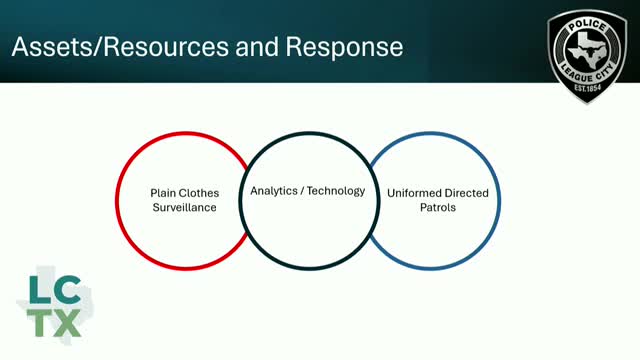City leaders propose innovative strategies to combat crime
September 10, 2024 | League City, Galveston County, Texas
This article was created by AI summarizing key points discussed. AI makes mistakes, so for full details and context, please refer to the video of the full meeting. Please report any errors so we can fix them. Report an error »

In a recent government meeting, city officials discussed strategies to enhance public safety and address nontraditional criminal offenses through a multidisciplinary approach. The dialogue emphasized the importance of collaboration among various city departments to identify problem locations and improve quality of life issues.
Officials proposed regular meetings with stakeholders from different departments, including fire services, to better analyze crime indicators and resource consumption. This initiative aims to create a more proactive response to issues that may not traditionally be classified as criminal but still strain city resources.
The meeting also highlighted the need to expand the technological capabilities of the police department. Officials discussed plans to enhance electronic surveillance methods, allowing for real-time monitoring without the need for constant human presence. This technological upgrade is seen as a way to optimize police resources and improve response times.
Additionally, there was a call for increasing the number of proactive investigative personnel, particularly plainclothes officers, to manage multiple incidents simultaneously without detracting from routine policing duties. This would enable the police to maintain a visible presence while still addressing specific crime hotspots effectively.
The discussion underscored the importance of interdepartmental collaboration, with officials encouraging departments outside of law enforcement to engage in data sharing and problem-solving. The mayor emphasized that early involvement of code enforcement could prevent minor issues from escalating into larger problems, thereby fostering a safer community.
Overall, the meeting set the stage for a more integrated approach to public safety, leveraging technology and cross-departmental cooperation to enhance the city's response to crime and community concerns.
Officials proposed regular meetings with stakeholders from different departments, including fire services, to better analyze crime indicators and resource consumption. This initiative aims to create a more proactive response to issues that may not traditionally be classified as criminal but still strain city resources.
The meeting also highlighted the need to expand the technological capabilities of the police department. Officials discussed plans to enhance electronic surveillance methods, allowing for real-time monitoring without the need for constant human presence. This technological upgrade is seen as a way to optimize police resources and improve response times.
Additionally, there was a call for increasing the number of proactive investigative personnel, particularly plainclothes officers, to manage multiple incidents simultaneously without detracting from routine policing duties. This would enable the police to maintain a visible presence while still addressing specific crime hotspots effectively.
The discussion underscored the importance of interdepartmental collaboration, with officials encouraging departments outside of law enforcement to engage in data sharing and problem-solving. The mayor emphasized that early involvement of code enforcement could prevent minor issues from escalating into larger problems, thereby fostering a safer community.
Overall, the meeting set the stage for a more integrated approach to public safety, leveraging technology and cross-departmental cooperation to enhance the city's response to crime and community concerns.
View full meeting
This article is based on a recent meeting—watch the full video and explore the complete transcript for deeper insights into the discussion.
View full meeting
